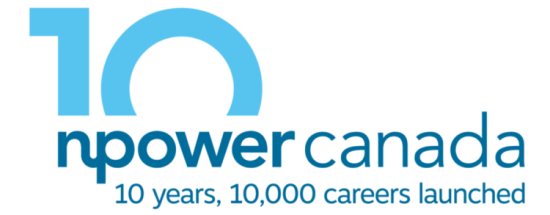By NPower Canada’s COO Andrew Reddin and Senior Vice President Denisse Alejo, December 15, 2021.
How to equip jobseekers to succeed in the digital era
Tech is no longer an isolated field, which means that workforce development programs must ensure their programs and services align with evolving tech needs and simultaneously prepare jobseekers with the professional and personal skills to enable them to succeed in any field.
The tech field has grown immensely in recent years, with Canada climbing the ranks of the largest tech hubs. According to CBRE, an investment firm that leverages market intelligence, from 2019-2020, Toronto ranked first in North America for high-tech software job growth, with Vancouver and Montreal ranking third and sixth.
When NPower Canada began in 2014, we intentionally designed our programs to prepare young jobseekers for the future of work, focusing on tech skills so our alumni would be prepared to enter the booming tech industry. Since then, we have seen steadily increased digitization and automation. According to the Scoring Canadian Tech Talent analysis of labour market conditions by CBRE, the number of tech talent workers increased by 22.5% from 2014 to 2019, adding 165,300 jobs to the economy.
According to Statistics Canada’s job vacancies report for the first quarter of 2021, vacancies for computer and information systems positions were up 12.3% – a record increase. Earlier work-from-home orders forced companies to realize that tech talent is needed regardless of the nature of the organization; every company has become a tech company.
Jobseekers must have some technical proficiency to fulfill the needs of employers, who are looking for motivated, diverse, adaptable employees who can help them grow and thrive within this digital era.
Holistic tech workforce development
While tech skills are vital to NPower Canada’s program delivery model, essential skills are equally important to strengthening employability and achieving career success.
In May 2021, the Government of Canada launched a new Skills for Success model as a response to evolving labour market needs. Some notable differences in the essential skills framework include the evolution of “computer use” to “digital skill” and “document use” now compromising reading, numeracy and writing, as these skills now occur predominantly in online spaces. These changes reflect the fact that tech is everywhere and that all roles now involve digital skills.
Other changes include transitions from “thinking” to “problem solving,” from “oral communication” to “communication,” and from “continuous learning” to “adaptability and creativity & innovation.” These changes reflect employers’ desire to recruit individuals who can think critically and become lifelong learners, as rapid technological shifts change how organizations operate and require talent that can quickly adapt to new processes.
Equipping jobseekers for success
To match these needs, NPower Canada’s training model is split into three components: tech training, personal development and professional development.
Tech training: Our programs provide participants with industry-recognized certifications and micro-credentials in tech. Micro-credentials are increasingly valued by employers as they demonstrate an individual’s continued commitment to learning and their prowess in the latest technological skills.
Personal development: The objective of this is to support and guide participants in building their personal brand to showcase talents that will allow them to stand out and increase their opportunities for employment.
Professional development: The goal of this is to help participants build their adaptability, problem-solving skills and resilience to overcome challenges in the workplace and to cultivate essential skills that are valuable in all industries.
We prioritize these three learning domains to equip our alumni with the following core competencies: being coachable, demonstrating a growth mindset and becoming technologically savvy with a thirst for more knowledge. We emphasize key traits that make an individual a valuable team member so that we can launch them into a long-term career, in whichever field they choose to enter.
Assessing the future of tech careers post-pandemic
In Spring 2021, NPower Canada worked with RBC to analyze the post-pandemic tech landscape. By working with some of Canada’s largest employers of IT talent, such as RBC, we ensure that our programs adapt to economic disruption by aligning with the evolving needs of employers. RBC’s analysis found that leveraging our existing employer relationships and finding opportunities for new potential partnerships has been one of NPower Canada’s greatest strengths, as it enables us to understand unique talent needs and gaps that our graduates can fill.
Leveraging partnerships and industry experts
Since in-demand skills have changed, innovation and continuous improvement of workforce development programs are vital. Workforce development organizations must leverage their existing partnerships to gain critical labour market intelligence.
At NPower Canada, we work closely with partners and industry experts to inform our programs. Our contacts are able to provide direct feedback on the tech skills they look for when hiring, so that our program content remains up to date despite economic disruptions.
“Since in-demand skills have changed, innovation and continuous improvement of workforce development programs are vital.”
An example of our pivot based on expert insight is that we have seen an increased need for tech talent to create accessible products and tools. Our Google UX Design program launches in January 2022 to meet this need.
Identify non-traditional markets
Since every tech is now a tech company, tech workforce development programs must broaden their scope when considering what fields their graduates will enter.
As part of RBC’s Roadmap for Success, we also worked with our employment partners to uncover potential unserved “non-tech” departments that also have job vacancies so that we can adapt our program content and delivery to equip our graduates for a greater range of opportunities.
For example, we currently offer a Google Project Management Program. According to a report by the Project Management Institute, demand for project managers is growing faster than demand for workers in other occupations. The program provides our alumni with transferable skills and continued upskilling for job placement, retention and career laddering.
Conclusion
It is thanks to our ability to be innovative and agile that NPower Canada continues to demonstrate competitive advantage and achieve an 80% success rate for employment and educational attainment post-program. This goal has been achieved consistently, even during the global pandemic, as we have expanded to offer our programs across four provinces: Alberta, British Columbia, Nova Scotia, and Ontario.
To remain competitive, tech-focused workforce development programs must equip individuals with personal and professional development skills that will complement their expertise in tech. These individuals will be employed in a variety of roles in diverse fields. Program providers must equip jobseekers with holistic skill sets so that they may enter meaningful and sustainable employment. Specific tech skills, when complemented with personal skills such as personal branding and professional skills like business writing, will allow participants of these programs to be prepared beyond their first job and be ready to grow their career.
It is through employer guidance and the involvement of industry experts, as well as the courage to look outside traditional scopes, that workforce development programs can adapt their curriculums to confidently equip jobseekers for success in today’s digital era.



